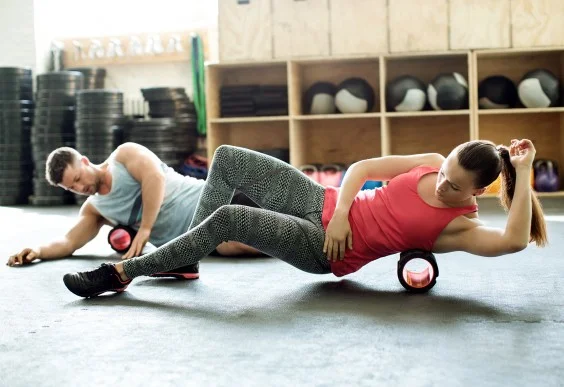A foam roller can be a valuable addition to your workout routine. That being said, the benefits of foam rolling might differ from person to person. So, if you want to buy this tool to enjoy its perks, you might be curious to know the things to consider before picking your next foam roller. This guide will help you in this regard.
You must carefully consider the density and surface texture before choosing the best suitable foam roller for them. Moreover, the size and shape of the roller are also essential factors to consider before making your purchase.
There are different types of foam rollers in the market, making it harder for novices to choose the right one. So, in this article, I’ll discuss the things to know before choosing your next foam roller, along with some other information you might find helpful.
Why Consider Getting A Foam Roller?
Foam rolling has many benefits, such as easing muscle pain, increasing range of motion, etc. Besides, it improves blood circulation and helps to prevent injuries.
Foam rolling provides the same advantages as a vigorous sports massage but without a high cost. Now, let’s go over some of the benefits of foam rolling:
Increase Your Motion Range
Foam rolling can help your body feel less stiff and more flexible before a workout. The fibers in tissues used while foam rolling change from a tight to an extended condition when they relax. It helps widen the range of motion around the joint that the muscles control. Therefore, it can improve motion and mobility.
Reduce Muscular Ache
Foam rolling may help to soothe tight muscles and lower inflammation. Furthermore, it might lessen the severity of DOMS (Delayed-onset muscle soreness). It is an aching ache that can develop within 24 to 48 hours following strenuous exercise. However, foam rolling improves blood and oxygen flow to exhausted muscles post-workout.
Moreover, it also prevents muscular adhesions. In this manner, foam rolling helps to lessen inflammation and discomfort within and around joints and muscles.
Increases Circulation
Using a foam roller for massaging tissues will result in increased blood circulation to those tissues. Because they often receive relatively minimal blood flow, ligaments, fascia, and tendons can benefit most from this.
Moreover, increased blood flow will enhance the distribution of essential nutrients. And it, as a result, helps maximize performance and recovery. Additionally, blood carries the glucose, oxygen, and other nutrients muscles and connective tissues require to contract and heal. So, it also makes the healing process faster.
Besides, foam rolling may also help cleanse these tissues with new nutrients and pump away toxins. So, it further aids in the elimination of inflammatory waste material.
Aid In Relaxing
Foam rolling also provides psychological benefits, including stated sensations of relaxation, release from stress and tension, and a boost in general mood. It is calming to a lot of individuals. You can feel less tense and more relaxed from releasing your muscle tension.
Many athletes claim foam rolling their entire body gently after training can mimic a massage. And it also improves feelings of general well-being and makes them more satisfied with their workouts.
Aids In Preventing Common Injuries
Preventing those all-too-common exercise-related injuries is among the most important benefits of a daily foam rolling practice. Too-tight muscles may contribute to iliotibial band syndrome (IT band syndrome) and other comparable flare-ups.
Moreover, foam rolling daily guarantees you are rubbing off fascia accumulation in the muscles. So, you may help avoid those places from developing into pain trigger points.
3 Things to Know Before Buying A Foam Roller
It’s not as simple as you would think to choose the ideal foam roller for yourself, but it’s crucial. The correct roller selection will promote efficiency, compliance, and usability. However, there are three primary factors to think about while purchasing a foam roller:
- Surface Texture
Some rollers contain knobs and ridges that let you massage specific body areas with varying pressure levels. There are also smooth rollers. Even pressure is applied along a roller’s length thanks to these rollers’ simple design. A smooth foam roller is an excellent option for those just starting with rolling since the force isn’t as strong as a textured roller.
Additionally, textured foam rollers are generally more costly than smooth rollers. However, the knobs and ridges of a foam roller may mimic a therapist’s hands. As a result, it may provide a more precisely focused massage to loosen your muscles. Well, most rollers come in various textures to help you discover the ideal pressure level.
- Density
Various foam roller densities are available, which is crucial in determining their success for a deep-tissue massage. Using a foam roller excessively can lead to trauma and bruises. So, it might cause discomfort and negatively impact your performance. On the other hand, using a foam roller too lightly can result in insufficient pressure.
If this is your first time using a foam roller, go for a softer one. You can utilize a denser or harder technique when your technique develops, and the muscles acclimate. Additionally, as they are more robust, thicker rollers are better for prolonged usage. After extensive usage, softer rollers may become permanently distorted, indicating the need to replace them.
- Size & Shape
There are many different sizes and forms of foam rollers. Long rollers are adaptable and a wise option for newbies. Since they are long enough to stretch your full back when positioned perpendicular to the spine, they are adequate for the back. While working on the hamstrings, quads, and other body regions provides more stability than shorter ones.
However, shorter lengths, for instance, twenty-four inches or less, can effectively target smaller areas like the calves and arms. Generally, column foam rollers are great for targeting specific muscles. And the smallest sizes are ideal for mobility and in gyms with limited floor space.
Common Mistakes To Avoid During Foam Rolling
Although foam rolling is safe, doing it wrong might be harmful to you. So, now, let’s go over a few mistakes to avoid during this exercise:
- Avoid Holding Your Breath
Your primary motivation for foam rolling is undoubtedly to relax tense muscles. And the neurological system can be quickly and naturally penetrated by deep-regulated breathing. Deep breathing encourages relaxation by engaging the parasympathetic nervous system. So, don’t hold your breath if you genuinely want tight muscles to relax.
- Don’t Roll Quickly
It takes time for the body to sense the force and undergo the necessary physiological changes. A rapid 1-2 over a region is a time waster. Ideally, linger for a short while.
So, target a sore region for around 30 seconds while spending roughly 60 to 90 seconds on each muscle group. More won’t be essential and might worsen things by causing soreness or bruising.
Conclusion
If you know how to use a foam roller properly, it might be one of the most important practices you can incorporate into your workout regimen. By now, you should know the things to consider before buying a foam roller.
Hopefully, you’ve found this article helpful. Thanks for reading through. Best wishes!

